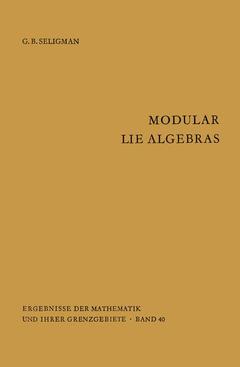Description
Modular Lie Algebras, Softcover reprint of the original 1st ed. 1967
Coll. Ergebnisse der Mathematik und ihrer Grenzgebiete. 2. Folge, Vol. 40
Author: Seligman Geoge B.
Language: French
Keywords
Finite; Lie; Lie group; Liescher Ring; Morphism; algebra; character; cohomology; form; function; group; homology; lie algebra; theorem; transformation
Publication date: 02-2012
166 p. · 15.2x22.9 cm · Paperback
166 p. · 15.2x22.9 cm · Paperback
Description
/li>Contents
/li>
The study of the structure of Lie algebras over arbitrary fields is now a little more than thirty years old. The first papers, to my know ledge, which undertook this study as an end in itself were those of JACOBSON (" Rational methods in the theory of Lie algebras ") in the Annals, and of LANDHERR ("Uber einfache Liesche Ringe") in the Hamburg Abhandlungen, both in 1935. Over fields of characteristic zero, these thirty years have seen the ideas and results inherited from LIE, KILLING, E. CARTAN and WEYL developed and given new depth, meaning and elegance by many contributors. Much of this work is presented in [47, 64, 128 and 234] of the bibliography. For those who find the rationalization for the study of Lie algebras in their connections with Lie groups, satisfying counterparts to these connections have been found over general non-modular fields, with the substitution of the formal groups of BOCHNER [40] (see also DIEUDONNE [108]), or that of the algebraic linear groups of CHEVALLEY [71], for the usual Lie group. In particular, the relation with algebraic linear groups has stimulated the study of Lie algebras of linear transformations. When one admits to consideration Lie algebras over a base field of positive characteristic (such are the algebras to which the title of this monograph refers), he encounters a new and initially confusing scene.
I. Fundamentals.- 1. Definitions.- 2. The Poincaré-Birkhoff-Witt theorem.- 3. Free Lie algebras. Restricted Lie algebras.- 4. Iwasawa’s theorem.- 5. Nilpotent Lie algebras. Engel’s theorem.- 6. Cartan subalgebras.- 7. Semisimplicity. The Killing form.- 8. Trace forms, derivations, and restrictedness.- 9. Extension of the base ring.- II. Classical Semisimple Lie Algebras.- 1. The Cartan decomposition.- 2. Split 3-dimensional algebras and applications.- 3. Classical Lie algebras.- 4. Strings of roots and Cartan integers.- 5. Fundamental root systems.- 6. Semisimplicity and simplicity.- 7. Determination of the fundamental systems.- 8. Existence of isomorphisms.- 9. The Weyl group.- 10. Existence of the classical algebras.- 11. Generalizations of the theory.- III. Automorphisms of the Classical Algebras.- 1. The Chevalley groups.- 2. The fundamental decomposition of G. Consequences.- 3. Structure of the Chevalley group.- 4. Conjugacy of Cartan subalgebras.- 5. Structure of the automorphism group.- 6. Realizations.- IV. Forms of the Classical Lie Algebras.- 1. Forms and splitting fields.- 2. Galois semi-automorphisms and 1-cohomology.- 3. Simple involutorial algebras and the types A — D.- 4. Derivation algebras of alternative and Jordan algebras.- 5. Other types.- 6. Finite fields.- 7. On automorphism groups.- V. Comparison of the Modular and Non-modular Cases.- 1. Solvable and nilpotent algebras.- 2. Representations.- 3. Cohomology.- 4. Known simple Lie algebras.- 5. Derivations.- 6. Extension of the base field.- 7. Cartan subalgebras.- 8. Nilpotent elements and special subalgebras.- VI. Related Topics.- 1. Nilpotent groups and Lie algebras. The restricted Burnside problem.- 2. Linear algebraic groups and Lie algebras.- 3. Formal groups, hyperalgebras and Liealgebras.- 4. Lie derivation algebras and purely inseparable extensions.- 5. Infinite-dimensional analogues of the classical Lie algebras.
© 2024 LAVOISIER S.A.S.
These books may interest you

Complex Semisimple Lie Algebras 52.74 €



